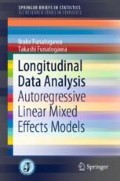Abstract
Previous chapters discussed linear mixed effects models and autoregressive linear mixed effects models for analysis of longitudinal data. This chapter discusses multivariate extensions of these models. In longitudinal clinical studies, multivariate responses are often collected at each measurement time point from each subject. When two response variables, such as an efficacy measurement and a safety measurement are obviously correlated, there are advantages in analyzing the bivariate responses jointly. Parathyroid hormone (PTH) and serum calcium (Ca) measurements in the treatment of secondary hyperparathyroidism in chronic hemodialysis patients provide an example in which joint bivariate responses are of interest. We introduce multivariate longitudinal data and explain bivariate autoregressive linear mixed effects models in which the current responses are regressed on the previous responses of both variables, fixed effects, and random effects. The dependent bivariate responses approach equilibria, and the equilibria are modeled using fixed and random effects. These type of profiles are observed in long-term clinical studies. We also explain bivariate linear mixed effects models.
Access this chapter
Tax calculation will be finalised at checkout
Purchases are for personal use only
References
Funatogawa I, Funatogawa T (2008) State space representation of an autoregressive linear mixed effects model for the analysis of longitudinal data. In: JSM Proceedings, biometrics section. American Statistical Association, pp 3057–3062
Funatogawa I, Funatogawa T (2012) Dose-response relationship from longitudinal data with response-dependent dose-modification using likelihood methods. Biometrical J 54:494–506
Funatogawa I, Funatogawa T, Ohashi Y (2007) An autoregressive linear mixed effects model for the analysis of longitudinal data which show profiles approaching asymptotes. Stat Med 26:2113–2130
Funatogawa I, Funatogawa T, Ohashi Y (2008) A bivariate autoregressive linear mixed effects model for the analysis of longitudinal data. Stat Med 27:6367–6378
Galecki AT (1994) General class of covariance structures for two or more repeated factors in longitudinal data analysis. Commun Stat Theor Methods 23:3105–3109
Harvey AC (1993) Time series models, 2nd edn. The MIT Press
Heitjan DF, Sharma D (1997) Modelling repeated-series longitudinal data. Stat Med 16:347–355
Jones RH (1993) Longitudinal data with serial correlation: a state-space approach. Chapman & Hall
Kurokawa K, Akizawa T, Suzuki M, Akiba T, Nishizawa Y, Ohashi Y, Ogata E, Slatopolsky E (2000) Effect of long-term administration of 22-oxacalcitriol (OCT) on secondary hyperparathyroidism in hemodialysis patients. Kidney Dial 48:875–897 (in Japanese)
Liu M, Taylor JMG, Belin TR (2000) Multiple imputation and posterior simulation for multivariate missing data in longitudinal studies. Biometrics 56:1157–1163
Liu Z, Cappola AR, Crofford LJ, Guo W (2014) Modeling bivariate longitudinal hormone profiles by hierarchical state space models. J Am Stat Assoc 109:108–118
Schuluchter MD (1990) Estimating correlation between alternative measures of disease progression in a longitudinal study. Stat Med 9:1175–1188
Searl SR (1982) Matrix algebra useful for statistics. Wiley
Shah A, Laird N, Schoenfeld D (1997) A random-effects models for multiple characteristics with possibly missing data. J Am Stat Assoc 92:775–779
Sy JP, Taylor JMG, Cumberland WG (1997) A stochastic model for the analysis of bivariate longitudinal AIDS data. Biometrics 53:542–555
Zeger SL, Liang K-Y (1991) Feedback models for discrete and continuous time series. Statistica Sinica 1:51–64
Zucker DM, Zerbe GO, Wu MC (1995) Inference for the association between coefficients in a multivariate growth curve model. Biometrics 51:413–424
Author information
Authors and Affiliations
Corresponding author
Rights and permissions
Copyright information
© 2018 The Author(s), under exclusive licence to Springer Nature Singapore Pte Ltd.
About this chapter
Cite this chapter
Funatogawa, I., Funatogawa, T. (2018). Multivariate Autoregressive Linear Mixed Effects Models. In: Longitudinal Data Analysis. SpringerBriefs in Statistics(). Springer, Singapore. https://doi.org/10.1007/978-981-10-0077-5_4
Download citation
DOI: https://doi.org/10.1007/978-981-10-0077-5_4
Published:
Publisher Name: Springer, Singapore
Print ISBN: 978-981-10-0076-8
Online ISBN: 978-981-10-0077-5
eBook Packages: Mathematics and StatisticsMathematics and Statistics (R0)

